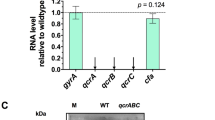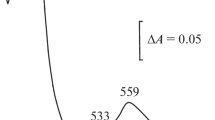Abstract
Transformation of carbon tetrachloride (CT) by Shewanella oneidensis MR-1 has been proposed to involve the anaerobic respiratory-chain component menaquinone. To investigate this hypothesis a series of menaquinone mutants were constructed. The menF mutant is blocked at the start of the menaquinone biosynthetic pathway. The menB, menA and menG mutants are all blocked towards the end of the pathway, being unable to produce 1,4-dihydroxy-2-naphthoic acid (DHNA), demethyl-menaquinone and menaquinone , respectively. Aerobically grown mutants unable to produce the menaquinone precursor DHNA (menF and menB mutants) showed a distinctly different CT transformation profile than mutants able to produce DHNA but unable to produce menaquinone (menA and menG mutants). While DHNA did not reduce CT in an abiotic assay, the addition of DHNA to the menF and menB mutants restored normal CT transformation activity. We conclude that a derivative of DHNA, that is distinct from menaquinone, is involved in the reduction of CT by aerobically grown S. oneidensis MR-1. When cells were grown anaerobically with trimethylamine-N-oxide as the terminal electron acceptor, all the menaquinone mutants showed wild-type levels of CT reduction. We conclude that S. oneidensis MR-1 produces two different factors capable of dehalogenating CT. The factor produced under anaerobic growth conditions is not a product of the menaquinone biosynthetic pathway.



Similar content being viewed by others
References
Arnold RG, Olson TM, Hoffman MR (1986) Kinetics and mechanism of dissimilative Fe(III) reduction by Pseudomonas sp. strain 200 ("Pseudomonas ferrireductans"). Appl Environ Microbiol 52:1657–1671
Bollag DM, Rozycki MD, Edelstein SJ (1996) Protein Method. Wiley-Liss, N.Y.
Daruwala R, Kwon O, Meganathan R, Hudspeth ME (1996) A new isochorismate synthase specifically involved in menaquinone (vitamin K2) biosynthesis encoded by the menF gene. FEMS Microbiol Lett 140:159–163
Hashsham SA, Freedman DL (1999) Enhanced biotransformation of carbon tetrachloride by Acetobacterium woodii upon addition of hydroxocobalamin and fructose. Appl Environ Microbiol 65:4537–4542
Lee CH, Lewis TA, Paszczynski A, Crawford RL (1999) Identification of an extracellular agent [correction of catalyst] of carbon tetrachloride dehalogenation from Pseudomonas stutzeri strain KC as pyridine-2,6-bis(thiocarboxylate). Biochem Biophys Res Commun 261:562–566
Miller JH (1972) Experiments in Molecular Genetics. Cold Spring Harbor Press, Cold Spring Harbor, N.Y.
Myers CR, Myers JM (1993) Role of menaquinone in the reduction of fumarate, nitrate, iron (III) and manganese (IV) by Shewanella putrefaciens MR-1. FEMS Microbiol Lett 114:215–222
Myers CR, Nealson KH (1988) Bacterial manganese reduction and growth with manganese oxide as the sole electron acceptor. Science 240:1319–1321
Palaniappan C, Sharma V, Hudspeth ME, Meganathan R (1992) Menaquinone (vitamin K2) biosynthesis: evidence that the Escherichia coli menD gene encodes both 2-succinyl-6-hydroxy-2,4-cyclohexadiene-1-carboxylic acid synthase and alpha-ketoglutarate decarboxlase activities. J Bacteriol 174:8111–8118
Penfold RJ, Pemberton JM (1992) An improved suicide vector for construction of chromosomal insertion mutations in bacteria. Gene 118:145–146
Petrovskis EA, Vogel TM, Adriaens P (1994) Effects of electron acceptors and donors on transformation of tetrachloromethane by Shewanella putrefaciens MR-1. FEMS Microbiol Lett 121:357–364
Petrovskis EA, Vogel TM, Saffarini DA, Nealson KH, Adriaens P (1995) Transformation of tetrachloromethane by Shewanella putrefaciens MR-1. In: Hinchee RE, Leeson A, Semprini L (eds) Bioremediation of chlorinated solvents. Battelle Press, Columbus, Ohio
Picardal FW, Arnold RG, Couch H, Little AM, Smith ME (1993) Involvement of cytochromes in the anaerobic biotransformation of tetrachloromethane by Shewanella putrefaciens 200. Appl Environ Microbiol 59:3763–3770
Picardal F, Arnold RG, Huey BB (1995) Effects of electron donor and acceptor conditions on reductive dehalogenation of tetrachloromethane by Shewanella putrefaciens 200. Appl Environ Microbiol 61:8–12
Sharma V, Suvarna K, Meganathan R, Hudspeth ME (1992) Menaquinone (vitamin K2) biosynthesis: nucleotide sequence and expression of the menB gene from Escherichia coli. J Bacteriol 174:5057–5062
Sharma V, Meganathan R, Hudspeth ME (1993) Menaquinone (vitamin K2) biosynthesis: cloning, nucleotide sequence, and expression of the menC gene from Escherichia coli. J Bacteriol 175:4917–4921
Sharma V, Hudspeth ME, Meganathan R (1996) Menaquinone (vitamin K2) biosynthesis: localization and characterization of the menE gene from Escherichia coli. Gene 168:43–48
Suvarna K, Stevenson D, Meganathan R, Hudspeth ME (1998) Menaquinone (vitamin K2) biosynthesis: localization and characterization of the menA gene from Escherichia coli. J Bacteriol 180:2782–2787
Acknowledgements
Preliminary sequence data was obtained from The Institute for Genomic Research website at http://www.tigr.org. Sequencing of Shewanella oneidensis MR-1 was accomplished with support from the Department of Energy's Microbial Genome Program. This work was funded by NIEHS grant no. 2 P42 ES04911–12 through the NIEHS Superfund Basic Research program of the Institute for Environmental Toxicology at Michigan State University. CHJY was funded by a subsidy from an undergraduate Research Fund from the Department of Civil and Environmental Engineering, Stanford University. Since this manuscript has not been reviewed by these agencies, no endorsement should be inferred. All experiments conducted in this paper comply with current United States law.
Author information
Authors and Affiliations
Corresponding author
Rights and permissions
About this article
Cite this article
Ward, M.J., Fu, Q.S., Rhoads, K.R. et al. A derivative of the menaquinone precursor 1,4-dihydroxy-2-naphthoate is involved in the reductive transformation of carbon tetrachloride by aerobically grown Shewanella oneidensis MR-1. Appl Microbiol Biotechnol 63, 571–577 (2004). https://doi.org/10.1007/s00253-003-1407-3
Received:
Revised:
Accepted:
Published:
Issue Date:
DOI: https://doi.org/10.1007/s00253-003-1407-3




